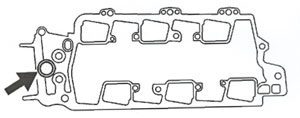This bulletin affects all 1995-1999 models with GM 3.8L engines. This bulletin, issued in September 2007, has been revised to add to the 1999 model year. You should discard the previous GM Corporate Bulletin Number 01-06-01-007B (Section 06 – Engine).
 Some installers/customers may comment on excessive engine coolant consumption, or an engine coolant leak near or under the throttle body area of the upper intake manifold.
Some installers/customers may comment on excessive engine coolant consumption, or an engine coolant leak near or under the throttle body area of the upper intake manifold.
This could be related to upper intake manifold composite material that may degrade around the EGR stove pipe and could result in an internal or external coolant leak.
To make the repair, follow the upper intake manifold removal instructions found in the Engine Unit Repair section of the service information manual.
Refer to the arrow in the illustration of the upper intake manifold (see Figure 1).
Inspect the inner diameter of the EGR passage for signs of material degradation. Degradation will appear as “pitting” of the composite material in the EGR port passage.
If degradation of upper intake manifold composite material is found, replace the lower and upper intake manifolds with the following part numbers:
Part Number Description
89017554 Gasket Kit, Upper Intake Manifold
89017272 Manifold Kit, Upper Intake
89017400 Gasket, Lower Intake Manifold
24508923 Manifold, Lower Intake
Follow the lower and upper intake manifold installation instructions found in the Engine Unit Repair section of the appropriate service manual.
If degradation is not apparent, evaluate the vehicle for other causes of excessive coolant consumption as noted in the Engine Diagnosis section of the appropriate service manual.













